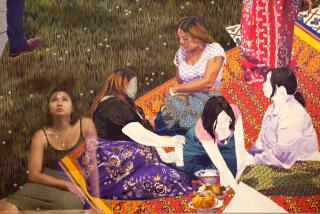An artists’ colony, on a Chinese scale
DAFEN, CHINA — Leonardo had Vinci. Georgia O’Keeffe had New Mexico. But the most productive place for their work has turned out to be this Chinese village.
In tiny garrets and vast factories, a few centuries’ worth of art emerges each day in the southern Chinese town of Dafen. In barely as much time as it took Michelangelo to paint the Sistine Chapel, this village has become one of the world’s largest producers of art, shipping more than $120 million last year in copied and original oil paintings to stores near you.
“A single painting is art. If you produce it in large quantities, it’s an industry,” said Wu Ruiqiu, 36, an artist-turned-factory chief.
Ever puzzled over the lush brushstrokes of a still life on a hotel wall? Or paused with embarrassed appreciation of an abstract on sale at a big-box store? You might be looking at the handiwork Zeng Xiangying, 18.
“We divide up the colors among us,” said Zeng, working briskly along a line of 10 identical contemporary-style paintings, applying a stripe of brown, while a teenage partner worked on the red. Surrounded by dozens more identical pieces at the sprawling Artlover factory, he explained, “By dividing up the work, contrasting colors stay clearest.”
This village near the flourishing city of Shenzhen is barely a footnote in China’s revolution of the global economy. But with abundant labor and efficient transportation, China has proved as adept at transforming where the world gets cheap art as it has in producing furniture, toys and electronics.
Local officials encourage specialization, and art factories benefit from sharing marketing and technology. So just as entire Chinese towns have devoted themselves to socks and neckties, Dafen’s niche is oil paintings.
Replicas of Van Gogh’s sunflower paintings are the biggest sellers -- at as little as $3 -- but offerings reach beyond the classics. There are crisp portraits of pop icons: Shakira, Kobe, Beckham. There is old Mao Tse-tung and young Mao Tse-tung, old Elvis and young Elvis.
There is Chinese President Hu Jintao, Yasser Arafat, Presidents Bush, Clinton and Bush again.
There is a painting of two pigs in tuxedos, singing at a piano. There are knockoffs of Thomas Kinkade, America’s mall-friendly schmaltz specialist, and Bob Ross, the soothing public-television art guru.
Some standards are high. Before it became one of the 19th century’s most recognizable paintings, “The Luncheon of the Boating Party” gave Pierre-Auguste Renoir so much trouble that he complained its ambitious lighting and portraits were “annoying me more and more.” But gallery owner Zeng Junfeng has no time for delays; he frowns at the $359 copy-in-progress drying on his balcony.
“The glasses aren’t perfect yet,” Zeng said, pointing to wine glasses in need of an Impressionist highlight.
The village story reads like the bio of an art world sensation. Unknown but industrious businessman Huang Jiang showed off local artists’ paintings at a Hong Kong art fair in 1989 and got more orders than he could handle. He hired assistants and got to work. By 2002, this village of tile-roofed homes and a single grocery store had sprouted 150 galleries. Today, it is abuzz with new buildings, a museum under construction, 700 galleries and 5,000 artists.
As word spread, the village became a magnet for aspiring artists, luring weekend painters out of their factory jobs across the Chinese countryside. Chen Hanwen, 33, was a train conductor in central China with a hidden talent, until he heard about Dafen. He quit his job in 2005 and set off across the country; now he is known around town for his meticulous pointillist ink sketches.
Not surprisingly, Dafen gets questions about intellectual-property rights. Town leaders and local authorities say Chinese law allows reproductions of artists who have been dead for more than 50 years, though O’Keeffe died in 1986.
Authorities recently opened an office to investigate and punish copyright violations. Since January, the Dafen Intellectual Property Working Station has been registering original works and taking photos, though the inspectors acknowledge that piracy remains rampant.
“There are too many works of art here,” said Liang Jian, art director at the protection office.
After mastering the masterpieces -- O’Keeffes and Michelangelos are popular in Europe, gallery owners say -- the village is turning its attention to another prize: America’s fondness for abstracts.
At Wu’s factory, young artists applied a few lusty brushstrokes, a shred of burlap and, voila, they had a distinctive decoration.
“Someday Dafen will have its own style,” said Wu, who also heads the local gallery association. “It will have its own Da Vinci and Van Gogh.”
Lu Jingxian contributed to this report.
More to Read
The biggest entertainment stories
Get our big stories about Hollywood, film, television, music, arts, culture and more right in your inbox as soon as they publish.
You may occasionally receive promotional content from the Los Angeles Times.










